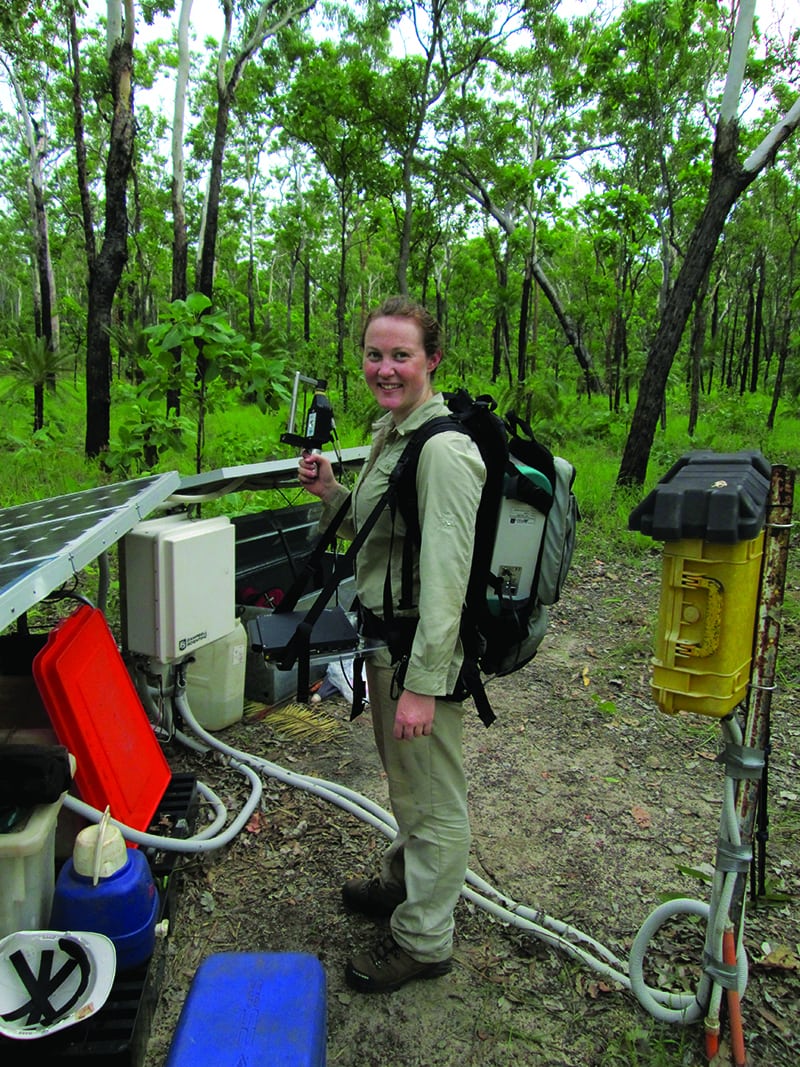A Monash University PhD student is using TERN’s imaging equipment to disentangle seasonal vegetation changes and help us better understand carbon dynamics
Spring is well and truly in the air. Flower buds bloom; new leaves open with effervescent greenness; and butterflies emerge from their cocoons. I’m sure we’ve all seem these quintessential springtime images in their amazing detail thanks to imagery captured using time-lapse cameras. Such imaging equipment is not only used to produce beautiful nature documentaries, it’s now being used in innovative ways that are generating useful scientific outcomes.
Monash University PhD student Caitlin Moore is using TERN’s network of time-lapse cameras to learn more about how our ecosystems change over time and help us more fully understand carbon dynamics.
Time-lapse cameras that monitor vegetation phenology (known as PhenoCams) have been installed on a number of OzFlux flux towers located at Australian SuperSite Network monitoring SuperSites around Australia. These PhenoCams collect repeat digital photographic images of vegetation, which allows for the monitoring of the direction and magnitude of changes to vegetation phenology due to climate change and extreme weather events.
Footage from a TERN PhenoCam at the Daintree Discovery Centre at the FNQ Rainforest SuperSite from 1 June to 16 September. Images are taken every 15 minutes during daylight hours. To minimise lighting variation, movie images are from 11am – 2pm. (Video courtesy of Justin Borevitz).
Caitlin has recently co-authored a paper in review in Science of the Total Environment, which was made possible by a recent ACEAS working group that highlights the value of PhenoCams for monitoring vegetation phenology in Australian ecosystems.
‘PhenoCams are cool,’ says Caitlin. ‘They enabled us to pick up on smaller scale phenology changes otherwise missed by the larger scale remote sensing approach.’
‘Whilst remote sensing provides a useful tool for characterising broad phenological diversity over the continent of Australia, PhenoCams provide a more detailed insight into site-specific changes that are not captured by remote sensing indices.’
‘For example, PhenoCams were able to capture individual tree canopy defoliation and flushing events in the Daintree rainforest, which is otherwise regarded as consistently evergreen.’
In addition to the recent paper, Caitlin’s PhD work is also using TERN’s network of PhenoCams. She is using PhenoCams alongside an array of state of the art sensors, including overstory and understory vegetation flux towers and spectrometers, to collect data on energy transfers, light radiation, and physical vegetation changes.
‘I’m aiming to separate gross primary productivity in savanna ecosystems into tree [overstory] and grass [understory] components to investigate the drivers of this productivity and how these drivers alter productivity contributions over time,’ says Caitlin.
Caitlin says that this information will be very useful in improving the current understanding of carbon uptake from savanna ecosystems – covering approximately 20% of the Earth’s land area. Caitlin’s initial results also suggest that her findings will be important for model evaluation, including those developed by TERN’s eMAST facility, and will assist policy makers and managers to sustainably manage Australian savannas into the future.
A digital image database is currently in development and work is progressing on the standardisation and automation of TERN’s PhenoCam network standards with other interested parties that were established at the 2014 ACEAS workshop. Caitlin’s work is an excellent showcase of how the TERN’s environmental research facilities can be collaboratively used, in this case by integrating SuperSites infrastructure, OzFlux data, AusCover remote sensing imagery, and eMAST models.
Caitlin’s PhD work is supervised by Jason Beringer (University of Western Australia), Bradley Evans (Macquarie University), Lindsay Hutley (Charles Darwin University) and Nigel Tapper (Monash University) and relies heavily on the infrastructure provided by TERN.

Monash University PhD student Caitlin Moore preparing her equipment before heading out to measure light radiation using a hand-held spectrometer at TERN’s Howard Springs research station, south-east of Darwin. Caitlin’s measurements will be linked with similar ones taken by AusCover and the Australian SuperSite Network across northern Australia to help understand what’s happening at a larger scale (photo courtesy of Caitlin Moore)
Published in TERN newsletter October 2014







